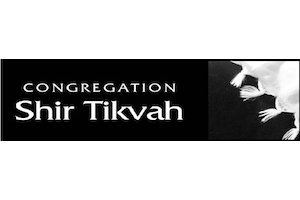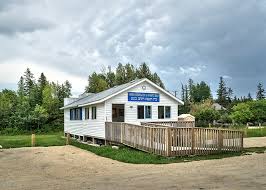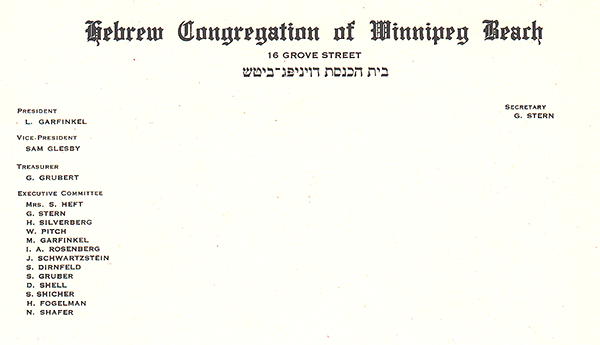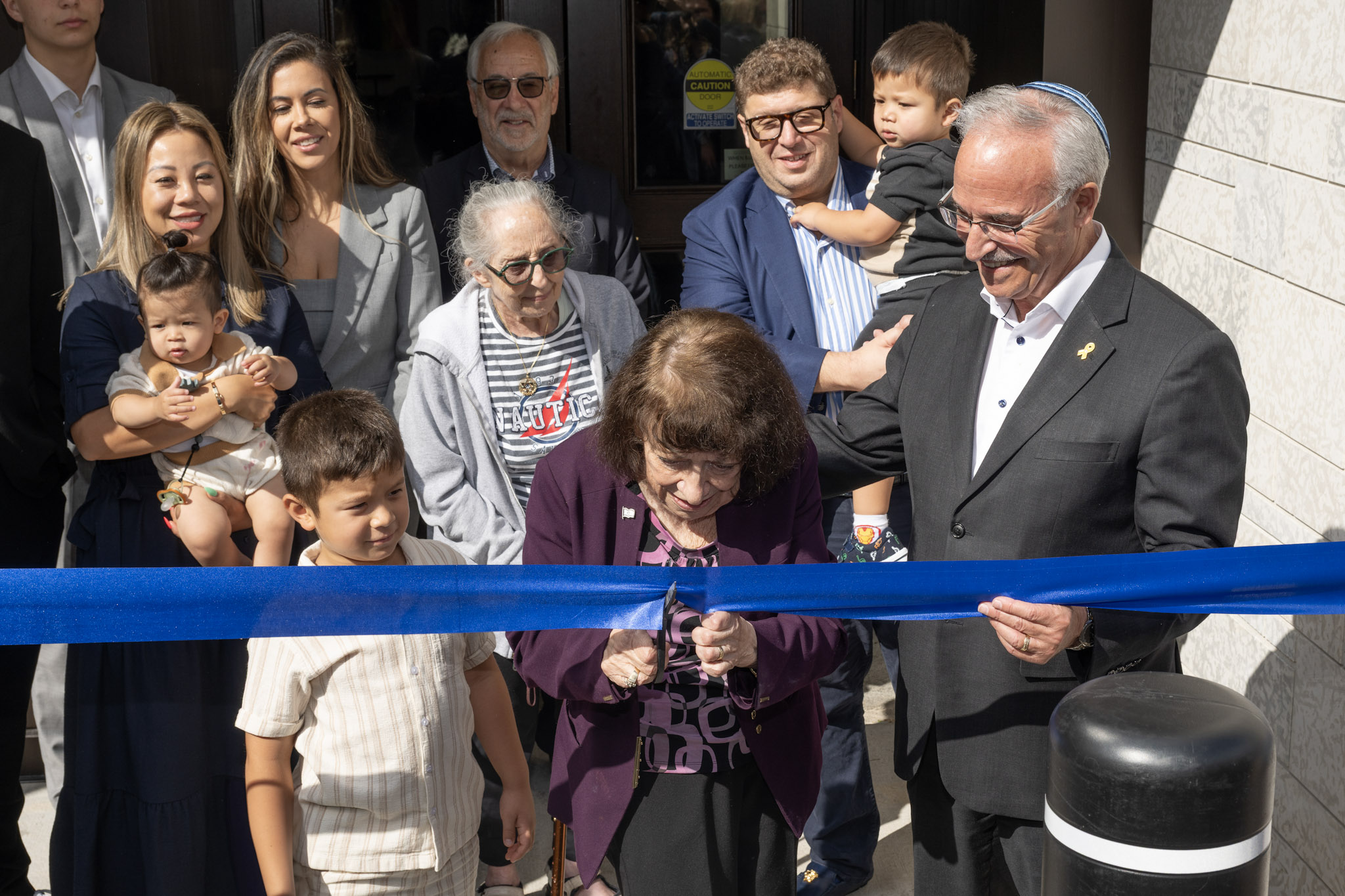Local News
Congregation Shir Tikvah officially dissolves
 By BERNIE BELLAN In our July 24, 2019 issue we broke the news that Congregation Shir Tikvah was ceasing operations. In that issue we reported that “A Winnipeg congregation that had been holding High Holy Day services for the past 16 years is ceasing operations. In that article we wrote that, in a letter sent to congregation members dated July 12, Congregation Shir Tikvah President Sharon Bronstone stated:
By BERNIE BELLAN In our July 24, 2019 issue we broke the news that Congregation Shir Tikvah was ceasing operations. In that issue we reported that “A Winnipeg congregation that had been holding High Holy Day services for the past 16 years is ceasing operations. In that article we wrote that, in a letter sent to congregation members dated July 12, Congregation Shir Tikvah President Sharon Bronstone stated:
Dear Members of Congregation Shir Tikvah,
On behalf of the Board of Directors and myself, it is with great sadness that we inform you of our decision not to hold High Holy Days Services this coming year.
After sixteen years in operation we can only see the writing on the wall that our numbers have been declining and at this time we don’t see a viable option to move forward.
When we started out no one thought our “little congregation” would ever amount to anything nor did anyone think Shir Tikvah would become a household name to hold Rosh Hashanah and Yom Kippur services for sixteen years.
While closing our doors is not what we had in mind, we do want you to know how important your presence, contributions and commitment has been to all of us. To be a part of an amazing group of people devoted to helping us thrive over the years has been incredibly heartwarming to everyone who has served on the Congregation Shir Tikvah Board as well as those behind the scenes. We applaud you for sticking by us!
As a follow-up to that story we were recently contacted by Sharon Bronstone to inform us that Congregation Shir Tikvah is now officially dissolved.
Among the several artifacts that the congregation had accumulated over the years were two Torah scrolls which had been donated to the congregation by Leonard Kahane in 2015. In a story I wrote that year I gave the explanation as to how those two Torah scrolls had ended up with Shir Tikvah. That story also told how the congregation had first come about:
It’s not often that a Jewish congregation in Winnipeg is able to commemorate something as momentous as the acquisition of a new Torah scroll. If memory serves correct, the last time any congregation here was able to mark such an occasion was in May 2012, when Temple Shalom celebrated the completion of the “Penn Torah scroll”, which was the crowning achievement of scribe Irma Penn shortly before her passing that same year.
Now, a congregation about whom we don’t hear very much is also about to unveil two new recently-acquired Torah scrolls. Congregation Shir Tikvah, which is in its 13th year, will be unveiling the two Torahs at its Rosh Hashanah service on Monday, September 15.
The Torah scrolls are the gifts of Dr. Leonard Kahane, in memory of his late wife, Hope Renee, who passed away in 2006.
Recently I sat down with three individuals who were instrumental in creating Shir Tikvah congregation and who have played vital roles in keeping that congregation alive every high holiday since 2003: Sid Ritter (the former executive director of Bnay Abraham Synagogue prior to the merger of that synagogue with the Beth Israel and Rosh Pina synagogues in 2002), his wife Hinda , and Sharon Bronstone (a past president of the Beth Israel congregation).
As much as I was interested in hearing the story of the Torah scrolls, I was even more interested in knowing what has led the various individuals who have gathered together each year at the Viscount Gort Hotel (save for two years at the old Blue and Gold room in the former Winnipeg Stadium) for high holiday services to stay together.
The story, for those not familiar with it, is that at the time that three north-end Winnipeg congregations – the Beth Israel, Bnay Abraham, and Rosh Pina, decided to merge into one in 2002, not all members of those congregations were enthused with the idea of the merger. According to Bronstone, “Some of us were not happy the way it (the merger) turned out…and Sid, David (Bloomfield, also one of the original movers behind the creation of Shir Tikvah and a past president of the Beth Israel), and I started getting phone calls from others, asking ‘What are you going to do?’ “
“Nobody really wanted to start anything,” says Bronstone, “but the phone calls kept coming in and we did start something – it was a one-shot deal, in 2003” (high holidays services in the basement of the Viscount Gort Hotel on Portage Avenue).
“The first year we had 83 people – which surprised us,” she notes. “It came around that we met a second year, also at the Viscount Gort.” Since then the number of people attending Shir Tikvah’s services has continued to grow, to the point where there are anywhere from 150-180 individuals now attending annually (although one year there were over 200 people in attendance, Bronstone notes.)
(Ed. note: In my conversation with Sharon Bronstone on March 10, 2021 Sharon offered the following observations about the original formation of Congregation Shir Tikvah:
“Some of us were younger people who weren’t comfortable going to a larger synagogue.
Rabbi Green (who was the rabbi at Congregation Beth Israel at one time) had suggested, when Shir Tikvah was first formed that (to paraphrase) “You’re doing something for people who do not want to belong to a synagogue, but wanted somewhere to go for High Holiday services.”)
Arky Berkal has served as cantor from day one, while Sharon’s son Adam has served as “lay rabbi”, also from the very beginning. (Every year Adam Bronstone has come back to Winnipeg for two weeks during the high holidays, no matter where he may have been living anywhere in the world.) In recent years, Jared Trotman has also been contributing as “Ba’al Shacharit”, this year to be joined on the bimah by Avrom Charach.
As far as Torah scrolls have gone though, the congregation had been in the practice of borrowing two scrolls belonging to the Gray Academy each year. Later, when those Torahs were sent for refurbishing, Shir Tikvah was able to borrow two more Torah scrolls from the Talmud Torah-Beth Jacob congregation on Main Street. Most recently it had been borrowing two Torahs from the Shaarey Zedek Synagogue.
Bronstone notes that, even though there “were 48 Torahs” in the Etz Chayim as a result of the merger of the three congregations and that the Simkin Centre also had a surplus of Torahs, “no one wanted to give any to us.”
But, last year, explains Bronstone, while they “were breaking fast, Dr. (Leonard) Kahane said to me ‘Is there anything I can do for you?’ I didn’t understand what he meant, so I said ‘I don’t think so.’”
“No, no, what I meant is ‘What are you short?’ “, Dr. Kahane continued, according to Bronstone. “Well, after Yom Tov, I called him,” she continues, and mentioned that they were short Torahs of their own, so “he made us a fantastic offer of two Torahs”.
At that point Hinda Ritter explains how Sid and Leonard Kahane went down to Florida to visit a store known as “Tradition”, whose owner specialized in the sale of Torahs “that have been reclaimed from the Holocaust”.
“The Torahs go to Israel,” Hinda adds, “where they’re vetted and fixed, and he (the owner of Tradition) gets them.” (The Torahs are kept near the Kotel, where authorized scribes are allowed to work on them, Sid Ritter explains later in the conversation.)
Sid Ritter adds: “There are two locations in the world where Holocaust Torahs are kept. One is in Jerusalem and the other location is London, England. My opinion is we ought to be getting Torahs from Jerusalem. Those Torahs are checked by an authorized scribe to make sure they are all kosher.”
(At this point I interjected, asking whether it was permissible to repair a Torah that had been severely damaged. According to Sid Ritter, it depends on the degree of damage.)
“I asked our contact in Florida whether it would be possible to obtain one Torah that came from Poland and one from Romania,” Sid continues, “because our donor’s family came from Romania.”
“After some back and forth, eventually two Torahs were found – one from Poland, and one from Romania – and that’s what we ended up with,” he says.
There was an added element to the purchase of the Torahs that entered into the equation, Sid adds: The weight of the Torahs. Theirs is an “egalitarian congregation”, he explains, and they didn’t want to acquire Torahs that would be too heavy for women to carry.
So, what are the components that go into adding to the weight of a particular Torah? Sid wondered. One obvious factor would be the weight of the scroller, or the “Etz Chayim,” as it is referred to. “It depends on whether it’s made of hardwood or softwood,” Sid explains. But, another added element is the type of ink used in creating a particular Torah. “The heavier the ink, the more massive the Torah – not so much the parchments – they’re largely the same,” he adds.
But, how do you know a Torah comes from Poland, for instance, while another comes from Romania? “It turns out that there are actually distinct styles,” Sid says, that can indicate where a Torah comes from.
I ask: “How much does a Torah go for anyway?”
Both Sharon and Sid chime in: “Lots!”
In addition to the actual scrolls, Dr. Kahane also paid for the Torah covers, which were made in Israel.
Since Congregation Shir Tikvah meets only for high holiday services, I ask where the Torahs will be kept during the rest of the year. It turns out that Sid Ritter will keep them in his own home – under conditions “that are reasonably temperature controlled”, he notes.
The ark and the podium used by Shir Tikvah were designed and built by Zvi Gitter, Sharon Bronstone says, and they’re meant to be easily disassembled. As a matter of fact, she notes, “ we have given them out when people have bar or bat mitzvahs in hotels.”
“We are, in my estimation, a real synagogue,” she adds, “because the only things we were lacking were our own Torahs”.
According to Sharon Bronstone, now that Shir Tikvah Congregation is officially dissolved, the two Torah scrolls that the congregation acquired in 2015 are to be given to the Chevra Mishnayes Congregation (about which we have a story on page 34.)
As well, Sharon adds, the ark and the podium mentioned in that 2015 story will be donated to Congregation Temple Shalom, along with the white gowns worked by the lay rabbi and cantor.
As far as the High Holiday books that had been accumulated by Shir Tikvah over the years, Sharon says, of the 160 books in the congregation’s possession, 60 have been able to find new homes in other congregations, but there are still 100 remaining to be donated. If anyone is interested in acquiring these books they are asked to contact Sharon at 204-338-5064.
Local News
Thank you to the community from the Chesed Shel Emes

We’re delighted to share a major milestone in our Capital Campaign, “Building on our Tradition.” Launched in November 2018, this campaign aimed to replace our outdated facility with a modern space tailored to our unique needs. Our new building is designed with ritual at its core, featuring ample preparation space, Shomer space, and storage, creating a warm and welcoming environment for our community during times of need.
We’re grateful to the nearly 1,000 generous donors who contributed over $4 million towards our new facility. A $750,000 mortgage will be retired in November 2025, completing this monumental project in just seven years.
We’re also thrilled to announce that our Chesed Shel Emes Endowment Fund has grown tenfold, from $15,000 to $150,000, thanks to you, the Jewish Foundation of Manitoba’s FundMatch program, and Million Dollar Match initiative in 2024. Our fund helps ensure that everyone can have a dignified Jewish funeral regardless of financial need.
As we look to the future, our goal remains to ensure the Chevra Kadisha continues to serve our community for generations to come. Our focus now shifts to replenishing our savings account and growing our JFM Endowment fund.
We’re deeply grateful for your support over the past several years.
It’s our privilege to serve our community with care and compassion.
With sincere appreciation,
Campaign cabinet: Hillel Kravetsky, Gerry Pritchard, Stuart Pudavick,
Jack Solomon, and Rena Boroditsky
Murray S. Greenfield, President
Local News
Winnipeg Beach Synagogue about to celebrate 75th anniversary

By BERNIE BELLAN (July 13) In 1950 a group of cottage owners at Winnipeg Beach took it upon themselves to relocate a one-room schoolhouse that was in the Beausejour area to Winnipeg Beach where it became the beach synagogue at the corner of Hazel and Grove.
There it stayed until 1998 when it was moved to its current location at Camp Massad.
On August 2nd members of the synagogue will be holding a 75th anniversary celebration.

As part of the celebration anyone who is a descendant or relative of any of the original members of the first executive committee (as seen in the photo here) is invited to attend the synagogue that morning.
If you are a relative please contact Abe Borzykowski at wpgbeachshule@shaw.ca or aborzykowski@shaw.ca to let Abe know you might be attending or for more information about the 75th anniversary celebration.
We will soon be publishing a story about the history of the beach synagogue, which is something I’ve been writing about for over 25 years.
Local News
Vickar Family cuts ribbon on new Tova Vickar and Family Childcare Centre

By MYRON LOVE In the words of Larry Vickar, the Shaarey Zedek’s successful Dor V’ Dor Campaign “is not only a renewal of the synagogue but truly a renewal movement of Jewish life in our community.”An integral part of that renewal movement was the creation of a daycare centre within the expanded synagogue. On Monday, June 23, Larry and Tova Vickar cut the ribbon, thereby officially opening the Tova Vickar and Family Childcare Centre in the presence of 100 of their family members, friends and other supporters of the project.
The short program preceding the morning ribbon-cutting began with a continental breakfast followed by a welcome by both Fanny Levy, Shaarey Zedek’s Board President, and Executive Director Dr. Rena Secter Elbaze. In Elbaze’s remarks, she noted that Larry and Tova wanted their family (including son Stephen and family, who flew in from Florida) and friends at the event to celebrate the opening of the Tova Vickar and Family Childcare Centre, “not because of the accolades, but because, as Larry put it, he hopes that their investment in the congregation will inspire others to do the same.”
“When Larry and I spoke about what this gift meant to him and the message he wanted people to take away,” she continued, “I couldn’t help but connect it to the teachings of Reb Zalman Schachter-Shalomi whose book – Age-ing to Sage-ing – changes the whole way we look at the concept of ageing and basing it on our ancestral teachings.”
She explained that his concept of “Sage-ing” is based on three key ideas – Discover your meaning and purpose; accept our mortality and think about the legacy you want to leave.
“Larry spoke about these exact concepts when we met,” she said.
Elbaze also noted the presence of Shaarey Zedek’s newly-arrived senior Rabbi Carnie Rose, former Rabbi Alan Green, and area MLAs Mike Moroz and Carla Compton.
Larry Vickar expressed his great appreciation for all those in attendance. “Tova and I are deeply moved to stand here with you today for this important milestone in our community”, he said. “We are grateful to be surrounded by all of you, the people we care about, our family and friends… you who have touched our lives and played some part in our journey.”
